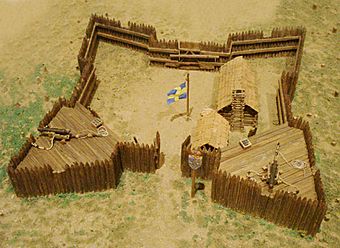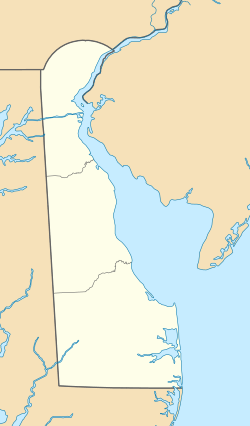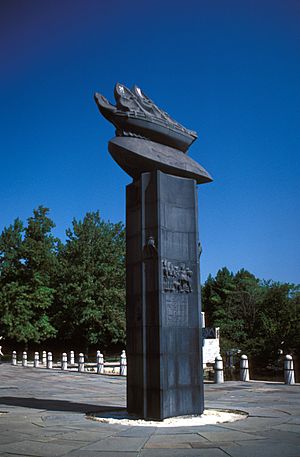Fort Christina facts for kids
|
Fort Christina
|
|

Model of Fort Christina at the American Swedish Historical Museum in Philadelphia
|
|
| Location | East 7th St. at the Christina River, Wilmington, Delaware |
|---|---|
| Built | 1638 |
| NRHP reference No. | 66000260 |
Quick facts for kids Significant dates |
|
| Added to NRHP | October 15, 1966 |
| Designated NHL | November 5, 1961 |
Fort Christina (also known as Fort Altena) was the very first Swedish settlement in North America. It was the main town of the New Sweden colony.
The fort was built in 1638 and named after Queen Christina of Sweden. It was located about 1 mile (1.6 km) east of downtown Wilmington, Delaware. This spot was important because it was where the Brandywine River and the Christina River joined, close to the Delaware River.
Contents
History of Fort Christina
Swedish Arrival and Building the Fort
The idea for a Swedish colony in North America came from King Gustavus Adolphus of Sweden. On March 29, 1638, the Swedes arrived in Delaware Bay. They sailed on two ships, the Kalmar Nyckel and the Fogel Grip. Their leader was Peter Minuit, who used to be in charge of the New Netherland colony.
They landed at a place along the Christina River called "The Rocks." This spot had a natural stone wharf. Minuit chose this location because it was great for trading beaver furs with the local Lenape people. He also thought it would be easy to defend. So, he ordered a fort to be built there using earthworks.
Claims and Defenses
At that time, the Dutch had claimed the area south to the Delaware River. The Swedes claimed land for the Realm of Sweden on the south side of the Delaware. This land included much of what is now the state of Delaware. It also included parts of southeastern Pennsylvania and southern New Jersey.
In 1640, Governor Peter Hollander Ridder made the fort's earthworks stronger. This was to protect against possible attacks from the Dutch or Native Americans. As more Swedish colonists arrived, they built homes and farms outside the fort. The fort was completely rebuilt in 1647.
Conflicts with the Dutch
The New Sweden colony often had problems with the Dutch. In 1651, the Dutch, led by Peter Stuyvesant, built Fort Casimir. This fort was only 7 miles (12 km) south of Fort Christina, near what is now New Castle. It was meant to threaten the Swedish settlement.
In 1654, the Swedes, under Governor Johan Risingh, captured Fort Casimir. Risingh was worried about the Dutch fighting back. So, he made Fort Christina's defenses even stronger by adding a wooden fence (palisade) around the earthworks.
In 1655, the Dutch, again led by Stuyvesant, returned with a large force. They surrounded Fort Christina and attacked it. After ten days, the fort surrendered. This ended Sweden's official presence as a colony in North America. However, most Swedish colonists stayed. The Dutch allowed them to keep their language and religious practices. Stuyvesant renamed Fort Christina to Fort Altena.
Later History of the Site
The land remained part of New Netherland until 1664. That year, an English fleet took over the area, and it became part of the English possessions. Under English rule, the original Swedish fort at "The Rocks" slowly fell apart and disappeared.
New forts were built on the same spot during the American Revolutionary War. During the War of 1812, Americans built Fort Union there. Important people like Caesar Augustus Rodney and James A. Bayard Sr. helped defend the fort.
In the 1800s, the area where the fort once stood became a busy industrial place. Factories, like those for the Jackson and Sharp Company, were built there.
Fort Christina National Historic Landmark
Celebrating 300 Years
In 1938, the state of Delaware created a park to celebrate 300 years since the Swedes first settled the area. This park included "The Rocks" and the site of the old forts.
Many important people attended the park's dedication. These included U.S. President Franklin D. Roosevelt, Crown Prince Gustav Adolf of Sweden, Crown Princess Louise, and Prince Bertil. The Prince gave a special gift from Sweden: a monument designed by Swedish sculptor Carl Milles. The monument had a replica of the Kalmar Nyckel ship on top.
During the ceremony, Prince Gustav Adolf talked about how important the site was to both countries. He said the monument was a gift from the people of Sweden to the United States. He mentioned how the early Swedish settlers were brave pioneers who helped build America. President Roosevelt thanked him and noted that one of his own ancestors, William Beekman, had served as a leader in the New Sweden colony.
Recent Anniversaries and Recognition
In 2013, for the 375th anniversary of the Swedish landing, King Carl XVI Gustaf and Queen Silvia of Sweden visited. U.S. Vice President Joe Biden also joined them. They even re-enacted the landing of the Kalmar Nyckel at Fort Christina Park using a replica of the ship.
The site was named a National Historic Landmark in 1961. This means it's a very important historical place in the United States. In 2014, Fort Christina became part of the First State National Historical Park.
Today, Fort Christina Park is open to the public during certain times of the year, usually from Memorial Day to Labor Day. Visitors can explore the site and learn about its history.
Images for kids






